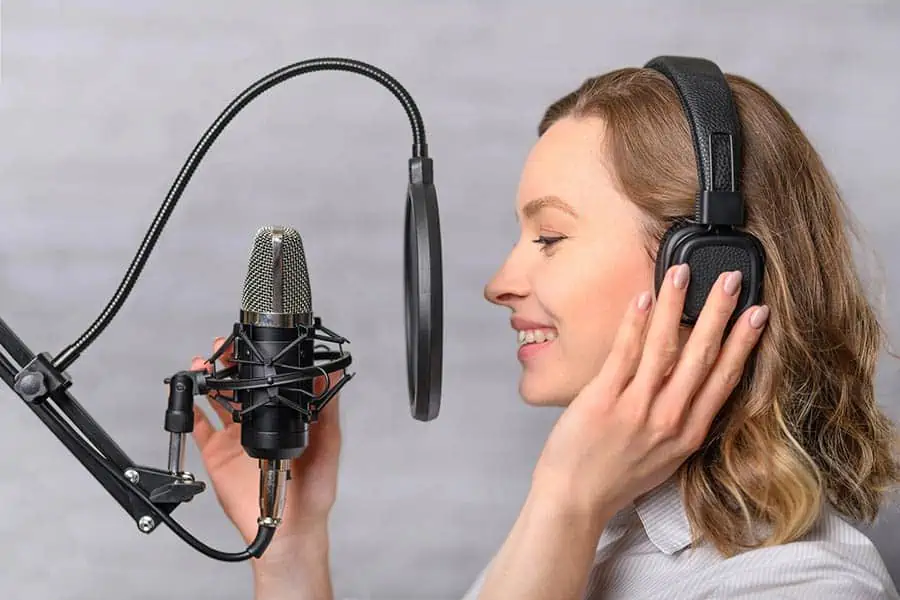DIY Video Studio is supported by its readers who use the affiliate links or ads on this site. As an Amazon Associate, I earn from qualifying purchases. Thank your support if you use any of the links.
Pop filters can be inexpensive, although you can pay a premium for a professional standard and branded pop filter or windscreen. However, the aim is always the same, to eliminate the pops caused by plosives.
Even so, many non-professionals inadvertently use a pop filter incorrectly. Since this seems to be a frequent problem, I decided to share what I’ve learned about using pop filters in my 40 years of working in professional broadcast and production studios.
Last update on 2025-04-14 / Affiliate links / Images from Amazon Product Advertising API
Does the pop filter go in front or behind the microphone?
Unfortunately, I have seen some pop filter manufacturers include misleading diagrams in their online advertising. These seem to imply that the pop filter goes behind the microphone. Some of these marketing materials also include equally misleading photographs. To let the potential buyer see the product brand name, the pop filter is tilted away from the person speaking into the microphone.
Pop filters should be placed in front and NOT behind or to the side of the microphone. To be precise, they should be between you and the microphone. Foam windscreens slip over the active part of the microphone, while pop filters are placed between the person speaking and the microphone.
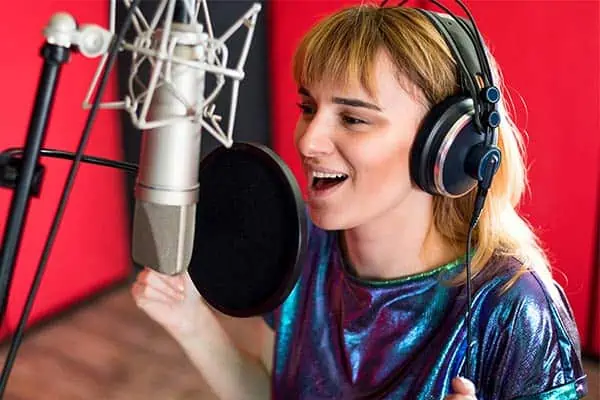
How far should the pop filter be from the mic?
This is another area where inexperienced users can get things wrong.
A pop filter, such as the fabric mesh or metal screen designs, should be 4 inches (100mm) in front of the microphone. This gap ensures that wind diffusion in fabric mesh filters or wind deflection in metal screen filters can fully prevent the moving air from striking the mic capsule and causing a pop.
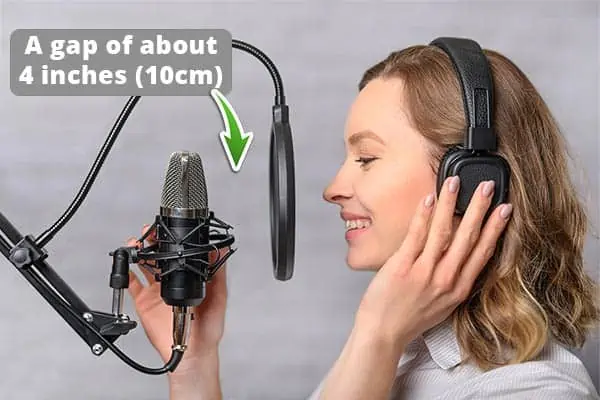
You do not need a measuring tape to get the correct spacing between the pop filter and microphone. All is to make a fist with your hand, the distance across your knuckles and the edge of your thumb should be about 4 inches.
Place the side of your fist against the microphone, then move the pop filter so it touches your thumb. Now take your hand away without disturbing the pop filter. The space left between the pop filter and microphone is how close a pop filter should be to a mic to ensure the microphone does not pick up any pops in your speech.
Note that foam windscreens are a little different. They are designed to slip over the part of the microphone you speak into, therefore, they are directly in contact with the microphone. Although the thickness of the foam material varies, it is seldom as much as 4 inches.
How close should you be to a pop filter?
Now that you have placed the pop filter at the correct distance to the microphone.
Your ideal distance from the pop filter can vary, depending on the tone you are after. For the warm “close-mic” sound you may wish to be an inch or two from the pop filter. But you should aim to be about 2-6 inches from the pop filter. This will ensure there are 6-10 inches between you and the microphone.

This kind of distance is about right when recording a podcast or voiceover, which is when you would tend to use a pop filter.
Do pop filters reduce or improve mic sound quality?
Pop filters and windscreens improve the microphone sound quality by eliminating the pops caused by plosives in speech. But they can also reduce the sound quality if made from materials that are not as acoustically transparent as possible. High frequencies can be lost, but the effect is usually very subtle.
The mesh-type pop filters that are frequently acoustically transparent are those that use foam with a low pore per inch (PPI) count that diffuses the wind in your breath and metal screens that deflect the wind but let the sound through. These types of pop filters either do not reduce the sound quality or have so little effect that most people would not notice it.
Some windscreens can deliberately reduce some of the high-end frequencies of certain microphones to enhance their warmth. So, in this case, it would be perfectly valid to argue that by cutting some frequencies in the sound the pop filter or windscreen is improving the sound quality.
Can you use a pop filter and foam windscreen together
Pop filters and foam windscreens can be used together, but for maximum effect, there should be an air gap between them. When recording outdoors using both can be advantageous since pop filters will deal with pops due to plosives and the windscreen will help reduce blasts due to a light breeze.
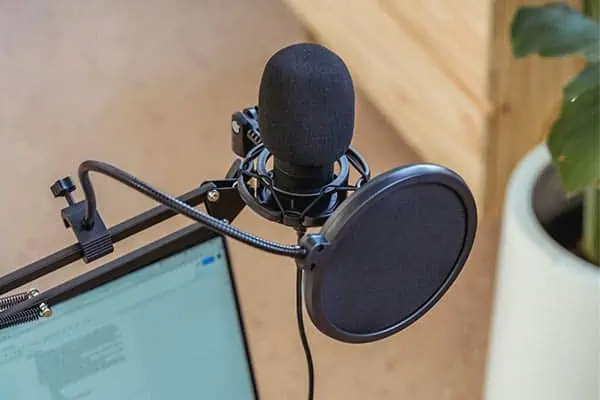
If recording outdoors a furry muff, or dead cat, is a better choice than a foam windscreen to prevent wind blasts due to a breeze. But when working indoors, because you are unlikely to encounter any wind, it is OK to use a foam windscreen along with a pop filter.
The extra material between the speaker and microphone may reduce some high frequencies, however, it is likely to be minimal. If necessary, the effect on your recording can be corrected in your DAW using a graphic equalizer.
Are pop filters supplied with microphones?
Microphones are not generally shipped with an included windscreen or pop filter. Although the extra cost of including a windscreen might be minimal, it could be an unnecessary cost. Most microphone users have their own preferences when it comes to pop filters, so may not use one that is included with the mic.
Some people, especially those in a studio environment, might want a metal screen pop filter, like one made by Stedman, SE Electronics, or Gator Frameworks. However, others might prefer foam windscreens. So, including a pop filter with a microphone might be an extra and unnecessary cost.
Where a pop filter, or more correctly a windscreen, is supplied with a microphone it is likely to be a small on-camera shotgun mic. Examples include the various Rode Video microphones.
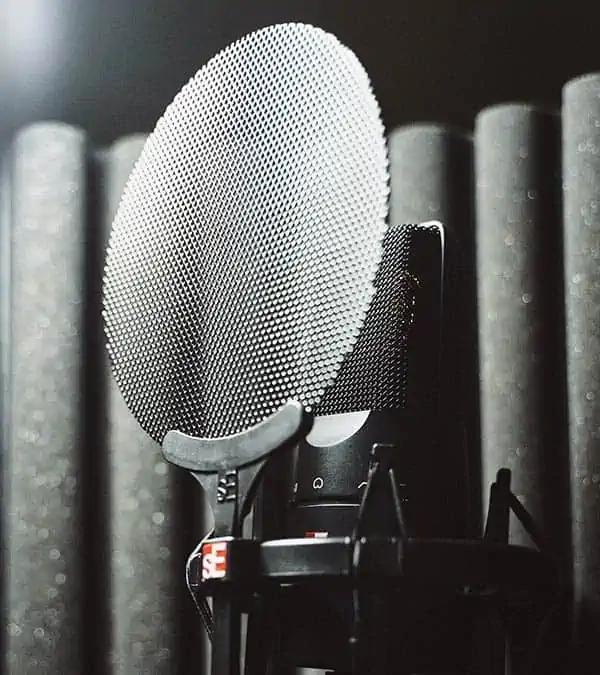
Can pop filters be used with all types of microphones
In theory, yes you can use a pop filter with any microphone, but in practice, this is not always possible or recommended.
For instance, you can use a foam or furry windscreen with a digital audio recorder, like the Zoom H5 recorder shown here. But, unless you mount the recorder on a stand, you probably would not use a pop filter because you would have two things to hold.
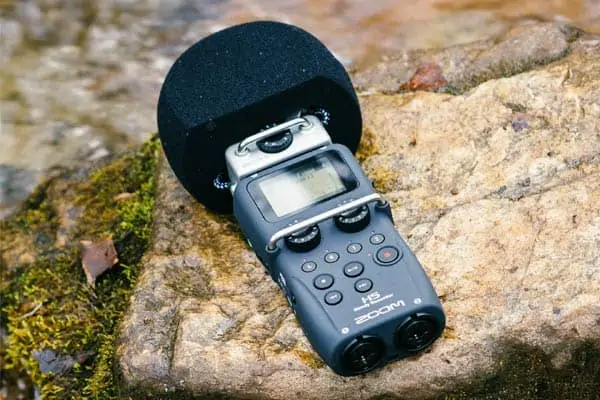
Nor would you use a pop filter with lavalier or shotgun microphones that are being used conventionally. Having said that, you might make an exception if using a shotgun mic to record a voiceover because you would be closer to the mic than normal.
Summary
Unless you know how a pop filter should be used it is easy to utilize it incorrectly. Foam windscreens and furry microphone muffs are placed directly on the microphone and therefore are directly in contact with the mic. Pop filters, both fabric mesh, and metal screen designs should be placed about 4 inches in front of the microphone. This will ensure the pop filter will have done its job of taking the energy out of the wind in your breath, and thus prevent pops from appearing in the recording.
Tosh Lubek runs an audio and video production business in the UK and has been using the Canon EOS R since it was released in the Autumn of 2018 and the Canon EOS R6 in 2020. He has used both cameras to shoot TV commercials broadcast on Sky TV, promotional business videos, videos of events and functions, and YouTube creator content. He has also won several international awards for his advertising and promotional work. You can meet him by visiting his “video booth” at HashTag Business Events across the country.
Recent Posts
Recently, I shot several customer testimonial videos in 4K for a client when the overheating warning on my Canon EOS R6 appeared. In fact, it appeared three times in five sessions during the day of...
Why Every Photographer Should Have a Nifty-Fifty 50mm f/1.8 Lens
If there’s one lens nearly every photographer should own, it’s the 50mm f/1.8 - better known as the “nifty fifty.” This affordable lens provides impressive quality and versatility, making it...


